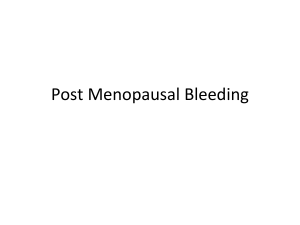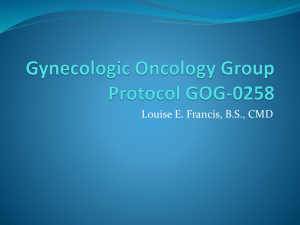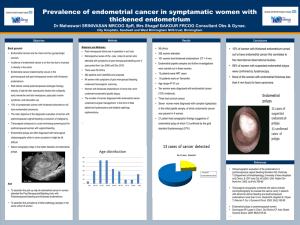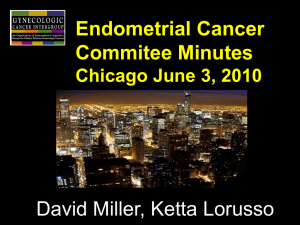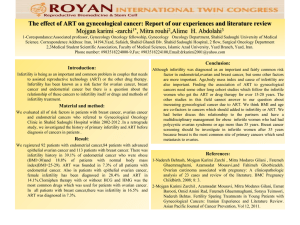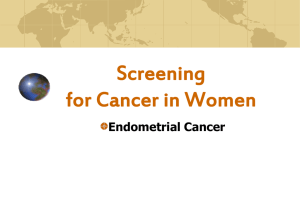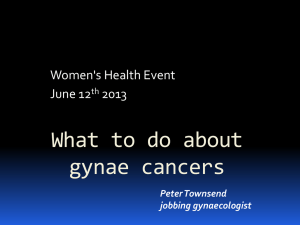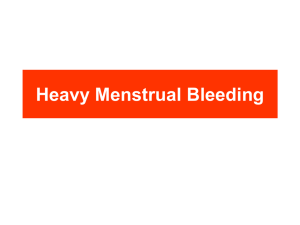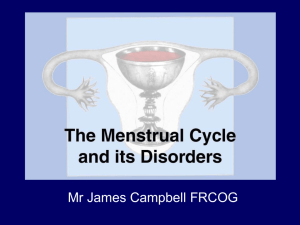Endometrial scratching
advertisement
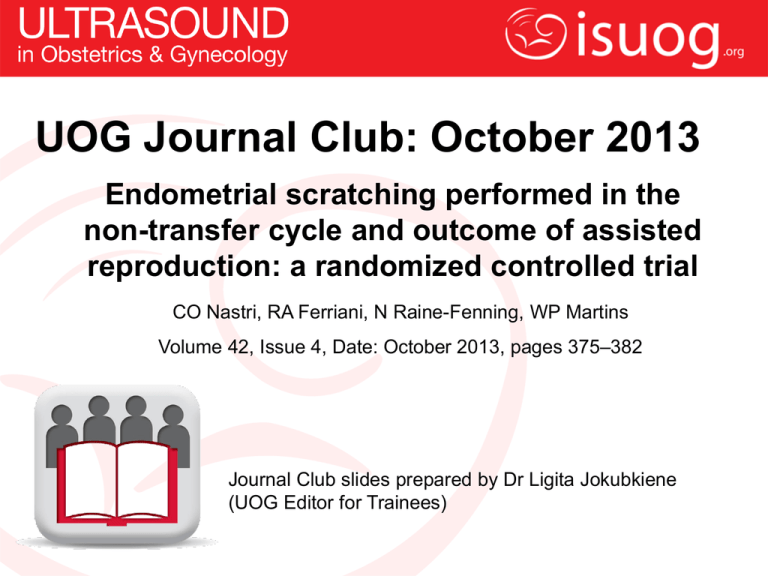
UOG Journal Club: October 2013 Endometrial scratching performed in the non-transfer cycle and outcome of assisted reproduction: a randomized controlled trial CO Nastri, RA Ferriani, N Raine-Fenning, WP Martins Volume 42, Issue 4, Date: October 2013, pages 375–382 Journal Club slides prepared by Dr Ligita Jokubkiene (UOG Editor for Trainees) • 7–15% women of reproductive age encounter fertility problems • Live birth rate in those using assisted reproductive techniques (ART) are 20–30% • ART outcome can be improved by: • Controlled ovarian stimulation (COS) • Multiple embryo transfer • Cryopreservation of oocytes/embryos Thoma et al., Fertil Steril 2013; Sunkara et al., 2011; Gunby et al., Fertil Steril 2011 Hypotheses • Endometrial scratching (ES) induces decidualization, improving the chances of embryonic implantation • ES induces the secretion of cytokines, interleukins, growth factors, macrophages and dendritic cells, all potentially beneficial to embryonic implantation • ES may lead to better synchronicity between endometrium and the transferred embryo Barash et al., Fertil Steril 2003; Li R and Hao G, Curr Opin Obstet Gynecol 2009; Garris DR and Garris BL, Tissue Cell 2003; Gnainsky Y et al., Fertil Steril 2010 Reproductive outcomes of ART compared in women with and without endometrial scratching The main reproductive outcomes that were shown to be improved by ES were: • Miscarriage • Clinical pregnancy • Live birth Karimzadeh et al., Aust N Z J Obstet Gynaecol 2009; Nastri et al., Gynecol Endocrinol 2013 Endometrial scratching performed in the non-transfer cycle and outcome of assisted reproduction: a randomized controlled trial Nastri et al, UOG, 2013 Objective: To investigate the effect of endometrial scratching on reproductive outcome, pain and three-dimensional power Doppler (3D-PD) vascular indices in women undergoing ART with combined oral contraceptive pre-treatment Randomized controlled trial Eligibility criteria: • Age < 38 years • Submitted for ART with controlled ovarian stimulation, oocyte retrieval and embryo transfer Pre-treatment: Combined oral contraceptives with: • 30mcg ethinyl estradiol • 150mcg levonorgestrel (for at least 10 days prior to randomization) Inclusion criteria: • Agreement to participate • Written informed consent Randomized controlled trial Endometrial biopsy with Pipelle de Cornier • • • OR A sham procedure (drying cervix with a gauze ) Randomization 7–14 days prior to planned COS Manipulation according to randomization for 30 seconds Evaluation of pain on visual analog scale (VAS) within 5 minutes after procedure Methodology • Tranvaginal ultrasound examination at day 2–3 of menstrual cycle • COS proceeded if no follicle ≥10mm in diameter was observed or if estradiol levels were <50pg/ml in the presence of a follicle ≥10mm • Transvaginal ultrasound monitoring of follicle development started 5 days after COS, and was repeated every other day • 3D-PD ultrasound examination was performed when at least one follicle ≥17mm was observed Methodology Ultrasound variables at 3D-PD examination: • Endometrial thickness • Endometrial volume • Vascularization index (VI) • Flow index (FI) • Vascularization flow index (VFI) VOCAL™ software analyzed the results, 15° rotation steps helped define the endometrium and a histogram facility for the calculation of PD vascular indices was used Outcomes Primary outcome: Clinical pregnancy per woman* Secondary outcomes: • Live birth per woman • Multiple pregnancy per woman • Spontaneous miscarriage per clinical pregnancy • Pain during procedure • Ultrasound variables *at least one fetus with heart beat Flow chart of patients The study stopped after 158 patients had been included The study was stopped after fourth interim analysis because a signficant difference in clinical pregnancy was observed IVF = in-vitro fertilization, ICSI = intracytoplasmic sperm injection Results on reproductive outcomes Outcome Endometrial scratching Sham procedure P-value* Live birth 33/79 (42%) 18/79 (23%) 0.01 Clinical pregnancy 39/79 (49%) 23/79 (29%) 0.01 Multiple pregnancy 9/39 (23%) 6/23 (26%) 0.79 Miscarriage 6/39 (15%) 5/23 (22%) 0.53 Pain VAS, cm (mean (SD)) 6.4 (2.35) 1.8 (1.52) <0.001† *Mantel-Haenszel test, †unpaired t-test Results • Endometrial scratching was associated with increased live birth and clinical pregnancy rates (P=0.01 for both) • Endometrial scratching was associated with considerable pain (P<0.001) • No difference was observed in endometrial thickness or volume (P=0.59 and P=0.51, respectively) • VI and VFI were increased in endometrial scratch group but no difference in FI observed (P<0.01, P<0.01 & P=0.65, respectively) Limitations The study was stopped after interim analysis – risk of overestimating treatment effect • Selected population - majority of women had at least 2 unsuccessful embryo transfers prior to this trial • The COS regimen was not standardized – choice of 3 regimens may introduce bias • Intervention pain - might have affected blind randomization • 3D-PD quantification lacked standardization dependent on machine settings and attenuation Endometrial scratching performed in the non-transfer cycle and outcome of assisted reproduction: a randomized controlled trial Nastri et al, UOG, 2013 Conclusions 1. Endometrial scratching is a reasonable procedure to improve reproductive outcome for women undergoing ART, particularly those with previous unsuccessful transfers 2. Further research is needed to elucidate the mechanisms of the benefit of endometrial scratching on reproductive outcome Endometrial scratching performed in the non-transfer cycle and outcome of assisted reproduction: a randomized controlled trial Nastri et al, UOG, 2013 Discussion Points • What are reproductive outcomes and how can we improve them? • Does endometrial scratching affect outcome of ART? • What are the underlying mechanisms between endometrial scratching and improved ART outcomes? • Can these results be applied to clinical practice? • What happens if a study is interrupted when a significant difference in study results is observed? • What are the limitations of this study?
